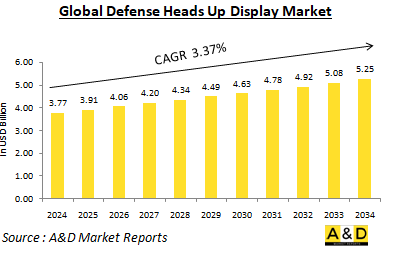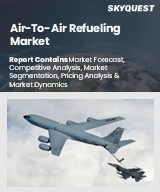
|
시장보고서
상품코드
1511770
세계의 방위용 헤드업 디스플레이(HUD) 시장(2024-2034년)Global Defense Heads Up Display Market 2024-2034 |
||||||
세계의 방위용 헤드업 디스플레이(HUD) 시장 규모는 2024년 37억 7,000만 달러로 추정되며, 2024년부터 2034년까지 예측 기간 동안 3.37%의 연평균 성장률(CAGR)로 성장하여 2034년 52억 5,000만 달러에 달할 것으로 예상됩니다.

세계 방위용 헤드업 디스플레이(HUD) 시장 개요
헤드업 디스플레이(HUD)는 조종사가 주요 시야에서 눈을 돌리지 않고도 중요한 비행 및 전술 정보를 제공함으로써 현대 군용 항공에 필수적인 요소로 자리 잡았습니다. 국방 분야에서 HUD는 상황 인식을 강화하고 조준 정확도를 향상시키며, 특히 시야가 좋지 않은 상황이나 스트레스가 많은 전투 시나리오에서 보다 안전한 작전을 수행하도록 설계되었습니다.
세계 방위용 헤드업 디스플레이(HUD) 시장에서 기술이 미치는 영향
HUD 기술의 발전은 군사 작전에 큰 영향을 미쳤습니다. 초기 HUD 시스템은 브라운관(CRT) 기술에 의존하여 이미지를 생성하고 이를 조종사 앞에 있는 투명 디스플레이에 투사하는 방식이었습니다. 1세대 HUD는 부피가 크고 전력 소모가 많았으며 기능도 제한적이었습니다. 액정표시장치(LCD) 및 OLED와 같은 디지털 디스플레이 기술로의 전환으로 HUD의 성능과 다용도성이 크게 향상되었습니다. 최신 HUD는 작고 가벼운 디자인을 유지하면서 무기 상태, 표적 지정, 센서 데이터 등 더 많은 정보를 표시할 수 있게 되었습니다. 이를 통해 전투기부터 수송기, 헬리콥터에 이르기까지 다양한 군용기에 탑재할 수 있게 되었습니다. 또한, 증강현실(AR) 기능을 HUD 시스템에 통합함으로써 상황 인식은 새로운 차원으로 발전했습니다. AR 지원 HUD는 가상 정보를 조종사의 실제 시야와 매끄럽게 결합하여 조종사의 시선을 외부 환경에 집중시키면서 향상된 목표물 추적, 지형 인식 및 미션 크리티컬한 데이터를 제공할 수 있습니다.
세계 방위용 헤드업 디스플레이(HUD) 시장의 주요 촉진요인
방어용 헤드업 디스플레이(HUD) 기술은 현대 항공 작전에 필수적인 몇 가지 설득력 있는 요인으로 인해 계속 발전하고 있습니다. 첫째, HUD는 조종사의 시야에 중요한 비행 및 전술 정보를 직접 제공함으로써 상황 인식을 크게 향상시킵니다. 이 기능을 통해 조종사는 외부 상황에 계속 집중할 수 있어 공간적 방향 감각 상실 위험을 최소화하고 역동적인 비행 상황에서 전반적인 작전 의식을 향상시킬 수 있습니다. 둘째, HUD 시스템은 조준 정확도와 무기 운반의 효율성을 향상시키는 데 매우 중요한 역할을 합니다. HUD는 정확한 조준 데이터, 무기 상태 및 유도 신호를 조종사의 시야에 겹쳐서 보다 정확한 표적과의 교전을 가능하게 합니다. 또한, HUD는 중요한 정보를 한 곳에 통합하여 조종사의 인지적 부담을 줄여줍니다. 이러한 통합을 통해 조종사는 다양한 계측기와 디스플레이 사이에서 주의를 분산시킬 필요가 줄어들어 의사결정의 속도와 정확성이 향상됩니다. 정보 전달을 간소화함으로써 조종사는 비행 관리 및 전술적 의사 결정에 더 많은 정신적 자원을 투입할 수 있어 궁극적으로 임무의 효율성을 높일 수 있습니다. 마지막으로, HUD 기술의 채택은 전반적인 비행 안전성을 향상시키는 데 도움이 되는 것으로 입증되었습니다. 이착륙 시 또는 시야가 좋지 않은 상황에서 중요한 비행 매개변수의 가시성을 향상시켜 조종사의 신뢰도를 높이고 사고 가능성을 줄입니다. 또한 HUD는 어려운 지형과 환경적 요인에도 불구하고 명확한 상황 인식을 제공함으로써 낮잠 비행과 같은 저고도 비행을 안전하게 수행할 수 있도록 돕습니다.
세계 방위용 헤드업 디스플레이(HUD) 시장의 지역별 동향
세계 국방용 헤드업 디스플레이(HUD) 시장은 다양한 지역에서 폭넓은 채택으로 강력한 성장세를 보이고 있습니다. 북미, 특히 미국에서는 F-35 Lightning II 및 F-22 Raptor와 같은 첨단 전투기에 HUD 기술을 통합하는 데 큰 초점을 맞추었습니다. 캐나다와 다른 북미 국가들 역시 군용 항공기용 HUD 기능에 대한 투자가 활발히 이루어지고 있으며, 이는 작전 효율성과 전투 준비태세 강화에 대한 의지를 반영하고 있습니다. 유럽 전역에서는 영국, 프랑스, 독일을 포함한 여러 국가들이 전투기, 수송기, 헬리콥터 등 다양한 항공기 플랫폼에 HUD 시스템을 개발 및 통합하고 있습니다. 유럽 연합 내 상호운용성 및 공동 작전 능력을 촉진하는 것은 광범위한 국방 현대화 노력과 일치하며 이러한 기술의 채택을 더욱 촉진하고 있습니다.
아시아태평양에서는 중국, 인도, 일본과 같은 국가들이 전투기, 수송기, 회전익 플랫폼과 같은 군용 항공 자산을 현대화하고 성능을 향상시키기 위해 국방 HUD 역량을 빠르게 확장하고 있습니다. 이러한 성장은 지역적 긴장과 기술적 우위를 유지하려는 전략적 요구에 의해 추진되고 있으며, 최첨단 HUD 기술에 대한 막대한 투자를 뒷받침하고 있습니다. 마찬가지로 중동에서는 이스라엘, 사우디아라비아, 아랍에미리트와 같은 국가들이 공군 역량을 강화하고 복잡한 군사 환경에서 작전 효율성을 높이기 위해 국방용 HUD 시스템에 많은 투자를 하고 있습니다. 현재 진행 중인 지역 분쟁과 고도의 전술적 능력 추구는 상황 인식과 임무 성공에 있어 HUD 기술의 중요한 역할을 강조하고 있습니다.
이러한 지역 외에도 라틴아메리카와 아프리카 국가들은 군용 항공 능력을 현대화하고 전반적인 전투 대응력을 향상시키기 위한 노력의 일환으로 국방 HUD 기술에 대한 관심을 높이고 있습니다. 이러한 세계 추세는 향상된 상황 인식, 정밀 조준 능력 및 임무 효율성을 포함한 고급 HUD 기능에 대한 수요 증가를 강조하며 세계 국방 HUD 시장의 지속적인 성장을 가속하고 있습니다. 전반적으로 국방용 HUD 시장 전망은 지속적인 기술 발전과 전 세계 군가 고급 기능을 활용하여 작전 수행 능력과 전략적 우위를 강화해야 할 필요성에 힘입어 계속해서 유망한 전망을 보이고 있습니다.
국방용 헤드업 디스플레이의 주요 프로그램
마이크로소프트는 군인들이 사용하는 헤드업 디스플레이(HUD) 업데이트를 육군으로부터 수주했으며, 통합 시각 증강 시스템(IVAS)은 상황 인식을 위한 도구를 갖추고 있으며, 병사들은 통일된 장치를 통해 리허설, 작전, 훈련을 할 수 있습니다. 이번 IVAS 1.2 버전은 인간 시스템과의 통합을 강화하기 위해 개선된 소프트웨어와 재설계된 폼팩터를 도입합니다. 또한 획득, 군수 및 기술 담당 육군 차관보 사무실에 따르면 편안함과 사용자 인터페이스를 개선하기 위해 새로운 헤드업 디스플레이를 탑재할 것이라고 밝혔습니다.
엘비트시스템즈(Elbit Systems of America)가 미국 육군을 대신하여 국방부 군수물자국으로부터 헬리콥터 조종사 지원 계약을 수주했습니다. 최대 약 5,000만 달러 규모의 5년 고정가격, 무기한 납품/무기한 수량 계약은 ANVIS HUD(Aviators' Night Vision Imaging System/Head-Up Display system)에 필요한 예비 부품 제조를 위한 것입니다. 이번 계약은 1,790만 달러 상당의 초기 주문이 이루어졌으며, 납품은 2023년까지 지속될 예정입니다.
본 보고서는 세계의 방위용 헤드업 디스플레이(HUD) 시장에 대해 분석했으며, 전체 시장 규모 동향 전망, 지역별/국가별 상세 동향, 주요 기술 개요, 시장 기회 등을 조사하여 전해드립니다.
목차
방위용 헤드업 디스플레이(HUD) 시장 : 보고서 정의
방위용 헤드업 디스플레이(HUD) 시장 내역
- 유형별
- 지역별
- 최종사용자별
방위용 헤드업 디스플레이(HUD) 시장 분석(향후 10년간)
방위용 헤드업 디스플레이(HUD) 시장 기술
세계의 헤드업 디스플레이(HUD) 시장 예측
방위용 헤드업 디스플레이(HUD) 시장 : 지역별 동향과 예측
- 북미
- 시장 성장 촉진요인 및 억제요인, 과제
- PEST 분석
- 시장 예측과 시나리오 분석
- 주요 기업
- 공급업체 Tier 상황
- 기업 벤치마킹
- 유럽
- 중동
- 아시아태평양
- 남미
방위용 헤드업 디스플레이(HUD) 시장 : 국가별 분석
- 미국
- 방위 계획
- 최신 동향
- 특허
- 현재의 시장 기술 성숙도
- 시장 예측과 시나리오 분석
- 캐나다
- 이탈리아
- 프랑스
- 독일
- 네덜란드
- 벨기에
- 스페인
- 스웨덴
- 그리스
- 호주
- 남아프리카공화국
- 인도
- 중국
- 러시아
- 한국
- 일본
- 말레이시아
- 싱가포르
- 브라질
방위용 헤드업 디스플레이(HUD) 시장 : 시장 기회 매트릭스
방위용 헤드업 디스플레이(HUD) 시장 : 조사에 관한 전문가의 견해
결론
Aviation and Defense Market Reports에 대해
LSH 24.07.23The Global Defense Heads up Display market is estimated at USD 3.77 billion in 2024, projected to grow to USD 5.25 billion by 2034 at a Compound Annual Growth Rate (CAGR) of 3.37% over the forecast period 2024-2034.

Introduction to Defense Heads-Up Displays Market:
Head-up displays (HUDs) have become an integral part of modern military aviation, providing pilots with critical flight and tactical information without requiring them to look away from their primary field of view. In the defense context, HUDs are designed to enhance situational awareness, improve targeting accuracy, and enable safer operations, especially during low-visibility conditions or high-stress combat scenarios.
Technology Impact in Defense Heads-Up Displays Market:
The evolution of HUD technology has had a profound impact on military operations. Early HUD systems relied on cathode-ray tube (CRT) technology to generate images, which were then projected onto a transparent display in front of the pilot. These first-generation HUDs were bulky, power-hungry, and had limited capabilities. The transition to digital display technologies, such as liquid crystal displays (LCDs) and organic light-emitting diodes (OLEDs), has significantly improved the performance and versatility of HUDs. Modern HUDs can now display a wider range of information, including weapon status, target designation, and sensor data, all while maintaining a compact and lightweight design. This has enabled their integration into a broader range of military aircraft, from fighter jets to transport planes and helicopters. Furthermore, the incorporation of augmented reality (AR) capabilities into HUD systems has taken situational awareness to new heights. By seamlessly blending virtual information with the pilot's real-world view, AR-enabled HUDs can provide enhanced target tracking, terrain awareness, and mission-critical data, all while keeping the pilot's eyes focused on the external environment.
Key Drivers in Defense Heads-Up Displays market:
Defense Heads-Up Display (HUD) technology continues to evolve driven by several compelling factors crucial to modern aerial operations. Firstly, HUDs significantly enhance situational awareness by providing pilots with critical flight and tactical information directly within their field of view. This capability allows them to maintain focus on external conditions, minimizing the risk of spatial disorientation and enhancing overall operational awareness during dynamic flight situations. Secondly, HUD systems play a pivotal role in improving targeting accuracy and weapon delivery effectiveness. By overlaying precise targeting data, weapon status, and guidance cues onto the pilot's view, HUDs enable more precise engagement of targets, especially vital in swiftly changing combat environments where split-second decisions are critical. Moreover, HUDs alleviate the cognitive burden on pilots by consolidating essential information in one location. This integration reduces the need for pilots to divert attention between various instruments and displays, thereby enhancing decision-making speed and accuracy. By streamlining information delivery, HUDs allow pilots to dedicate more mental resources to flight management and tactical decision-making, ultimately boosting mission effectiveness. Lastly, the adoption of HUD technology has proven instrumental in enhancing overall flight safety. Improved visibility of critical flight parameters during takeoff, landing, and low-visibility conditions enhances pilot confidence and reduces the likelihood of accidents. Furthermore, HUDs facilitate safer execution of low-altitude flight maneuvers, such as nap-of-the-earth operations, by providing clear situational awareness despite challenging terrain and environmental factors.
Regional Trends in Defense Heads-Up Displays Market:
The global defense Heads-Up Display (HUD) market is experiencing robust growth, spurred by widespread adoption across diverse regions. In North America, particularly in the United States, there is a prominent focus on integrating HUD technologies into advanced fighter aircraft such as the F-35 Lightning II and F-22 Raptor. This emphasis extends to Canada and other North American nations, where investments in HUD capabilities for military aviation fleets are actively underway, reflecting a commitment to enhancing operational effectiveness and combat readiness. Across Europe, nations including the United Kingdom, France, and Germany are advancing the development and integration of HUD systems across various aircraft platforms, including combat jets, transport planes, and helicopters. The push for interoperability and joint operational capabilities within the European Union further drives the adoption of these technologies, aligning with broader defense modernization efforts.
In the Asia-Pacific region, countries like China, India, and Japan are rapidly expanding their defense HUD capabilities to modernize military aviation assets and improve performance across fighter jets, transport aircraft, and rotary-wing platforms. This growth is propelled by regional tensions and strategic imperatives to maintain technological superiority, underpinning significant investments in cutting-edge HUD technologies. Similarly, in the Middle East, nations such as Israel, Saudi Arabia, and the United Arab Emirates are investing heavily in defense HUD systems to bolster their air force capabilities and enhance operational effectiveness in complex military environments. Ongoing regional conflicts and the pursuit of advanced tactical capabilities underscore the critical role of HUD technologies in enhancing situational awareness and mission success.
Beyond these regions, countries in Latin America and Africa are also showing increasing interest in defense HUD technologies as part of efforts to modernize their military aviation capabilities and elevate overall combat readiness. This global trend highlights the growing demand for advanced HUD functionalities, including enhanced situational awareness, precision targeting capabilities, and mission effectiveness, driving sustained growth in the global defense HUD market. Overall, the outlook for the defense HUD market remains promising, driven by ongoing technological advancements and the imperative for militaries worldwide to leverage advanced capabilities for enhanced operational performance and strategic advantage.
Key Heads Up Display Program:
Microsoft has been awarded an Army task order to upgrade the Heads-Up Display (HUD) used by soldiers. The Integrated Visual Augmentation System (IVAS) is equipped with tools for situational awareness, enabling soldiers to conduct rehearsals, operations, and training through a unified device. The upcoming IVAS 1.2 version will introduce software improvements and a redesigned form factor to enhance integration with human systems. It will also feature a new heads-up display aimed at improving comfort and user interface, according to the office of the Assistant Secretary of the Army for Acquisition, Logistics, and Technology.
Elbit Systems of America has secured a contract from the Defense Logistics Agency on behalf of the U.S. Army to support helicopter pilots. The five-year firm-fixed price, indefinite delivery/indefinite-quantity contract, valued at up to about $50 million, is for the production of spare parts needed for the Aviators' Night Vision Imaging System/Head-Up Display system (ANVIS HUD). An initial order worth $17.9 million has been placed under this contract, with deliveries expected to continue until 2023.
Table of Contents
Heads Up Display Market Report Definition
Heads Up Display Market Segmentation
By Type
By Region
By End user
Heads Up Display Market Analysis for next 10 Years
The 10-year heads up display market analysis would give a detailed overview of heads up display market growth, changing dynamics, technology adoption overviews and the overall market attractiveness is covered in this chapter.
Market Technologies of Heads Up Display Market
This segment covers the top 10 technologies that is expected to impact this market and the possible implications these technologies would have on the overall market.
Global Heads Up Display Market Forecast
The 10-year heads up display market forecast of this market is covered in detailed across the segments which are mentioned above.
Regional Heads Up Display Market Trends & Forecast
The regional heads up display market trends, drivers, restraints and Challenges of this market, the Political, Economic, Social and Technology aspects are covered in this segment. The market forecast and scenario analysis across regions are also covered in detailed in this segment. The last part of the regional analysis includes profiling of the key companies, supplier landscape and company benchmarking. The current market size is estimated based on the normal scenario.
North America
Drivers, Restraints and Challenges
PEST
Market Forecast & Scenario Analysis
Key Companies
Supplier Tier Landscape
Company Benchmarking
Europe
Middle East
APAC
South America
Country Analysis of Heads Up Display Market
This chapter deals with the key defense programs in this market, it also covers the latest news and patents which have been filed in this market. Country level 10 year market forecast and scenario analysis are also covered in this chapter.
US
Defense Programs
Latest News
Patents
Current levels of technology maturation in this market
Market Forecast & Scenario Analysis
Canada
Italy
France
Germany
Netherlands
Belgium
Spain
Sweden
Greece
Australia
South Africa
India
China
Russia
South Korea
Japan
Malaysia
Singapore
Brazil
Opportunity Matrix for Heads Up Display Market
The opportunity matrix helps the readers understand the high opportunity segments in this market.
Expert Opinions on Heads Up Display Market Report
Hear from our experts their opinion of the possible analysis for this market.
Conclusions
About Aviation and Defense Market Reports



















